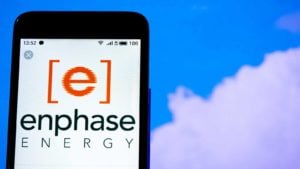Artificial intelligence (AI) holds promise for many industries, sparking public imagination about the capabilities it may one day attain. However, we must temper expectations when it comes to AI predictions for the stock market. While AI tools undoubtedly crunch vast amounts of data at speeds no human could match, even the most advanced models lack contextual understanding and reasoning ability.
Nonetheless, experimenting with AI for stock analysis can still prove educational. In that spirit, I decided to test drive Meta’s (NASDAQ:META) new natural language model Llama, prompting it to name the top three stocks it expects to outperform in 2024.
As with any stock recommendation, skepticism and independent verification is key. Thus, I will be providing my own opinion on these picks below. I expect you to do the same before you choose to invest. Let’s start!
Enphase Energy (ENPH)

I previously recommended Enphase Energy (NASDAQ:ENPH) near when the stock plunged to $75, punished too harshly amidst broad market turmoil. My thesis — Enphase would recover once conditions improved for the renewable energy industry — has partially played out, with shares bouncing back to the $130s. However, I believe there remains meaningful upside still to capture.
Revenue is projected to slip 16.6% next year as near-term headwinds linger. Still, margins should sustain, thanks to Enphase’s technological edge in microinverters. More exciting is the growth trajectory further out. By 2025, analysts forecast a sharp 38% revenue rebound. Enphase is one of few hardware makers simultaneously levered to surging electric vehicle (EV) adoption and the wider clean energy transition.
Consider the total addressable market for EV charging infrastructure. With EVs still comprising just 1% of vehicles on roads globally, we’ve only scratched the surface of potential demand. That creates a massive runway for Enphase to supply integrated solar and battery storage systems powering next-gen charging stations.
Additionally, while geopolitical instability has sidelined solar projects since 2022, renewable energy remains a long-term priority for policymakers, given climate goals. In the U.S., the recent Inflation Reduction Act extends solar tax credits through 2032. All things considered, I agree with Llama that ENPH can outperform next year.
Medtronic (MDT)

Medtronic (NYSE:MDT) likewise endured a steep 38% stock selloff from post-pandemic highs, which I view as overdone, given fundamentals. Shares have recovered just about 16% thus far. The company faces pressure. Revenue has stagnated near $30 billion since 2019 as hospitals delayed elective surgeries during COVID waves. Bottom-line growth also slowed.
Yet analysts expect Medtronic’s top line to improve starting next year, averaging 4% annual gains through 2029. Meanwhile, adjusted earnings per share should bounce back more sharply. Consensus calls for around 10% annual EPS expansion moving forward.
So, while headwinds linger, Medtronic’s stock correction overshot rational limits. The quality franchise trades at just 17 times forward earnings. Thus, an earnings-fueled rebound seems likely over the next 12 to 18 months as growth stabilizes. However, tagging Medtronic as a top performer feels like a stretch, given peers with stronger momentum.
Alphabet (GOOG, GOOGL)

Alphabet (NASDAQ:GOOG, NASDAQ:GOOGL) has been a laggard versus big tech peers and has been unable to impress Wall Street. Shares still sit 6% off highs. However, I’m warming back up to the stock at current levels.
No doubt, Alphabet faces pressures — advertising demand fluctuates with budgets while rising costs eroded margins last quarter. Zooming out, revenue and earnings should deliver double-digit growth for years to come. Consensus sees annual top-line and EPS gains both exceeding 10% through 2028, arguing for a higher valuation than the undemanding 24x forward multiple shares currently fetch.
Two exciting potential catalysts make me particularly constructive on Alphabet in the long. The first is traction in AI, as Google aims to compete with OpenAI’s ChatGPT conversational tool using its new Gemini model.
The second and nearer-term is ad revenue upside from YouTube’s anti-adblocking efforts. As the globe’s #2 most visited site, YouTube monetizes minimally, given the rampant usage of ad blockers. By restricting extensions that bypass ads, Alphabet could lift sales by making people opt for paid memberships. So, I agree it makes sense to go on your buy list, just not necessarily at the top regarding potential gains.
On the date of publication, Omor Ibne Ehsan did not hold (either directly or indirectly) any positions in the securities mentioned in this article. The opinions expressed in this article are those of the writer, subject to the InvestorPlace.com Publishing Guidelines.

